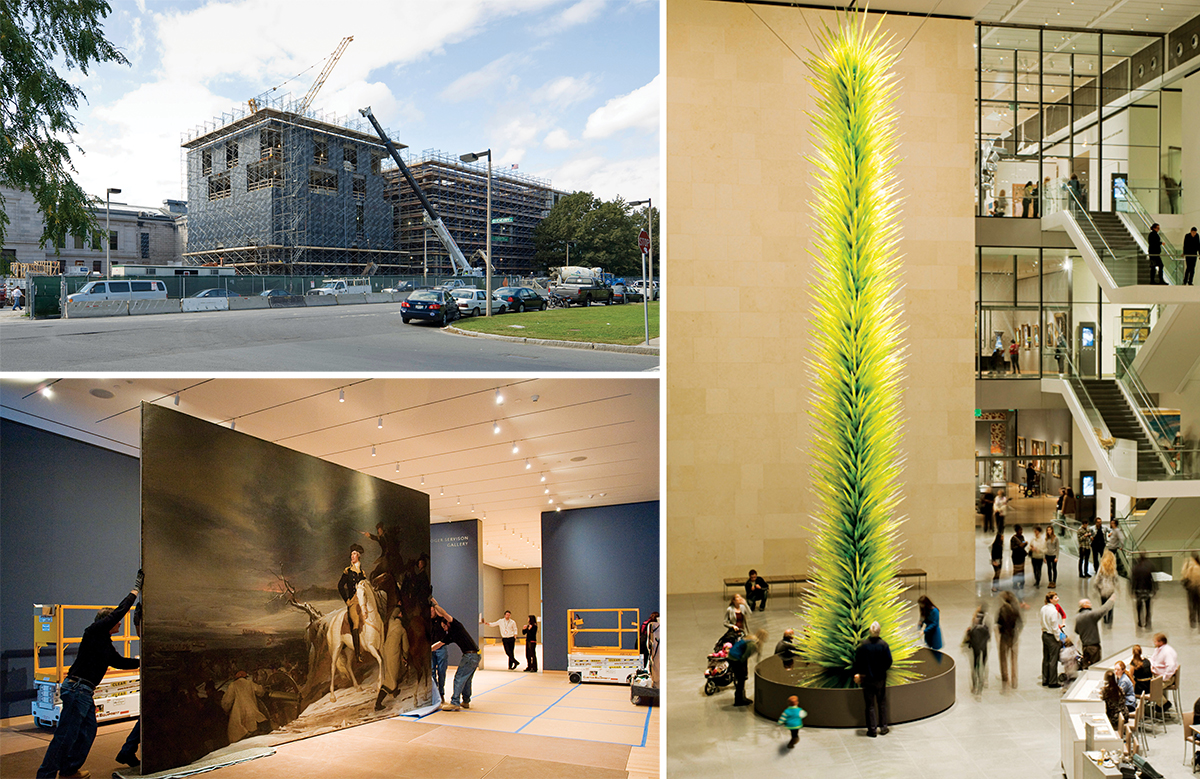Malcolm Rogers Has Left the Building

Clockwise from top left, the Art of the Americas Wing under construction in 2008; Dale Chihuly’s Lime Green Icicle Tower in the Ruth and Carl J. Shapiro Family Courtyard; workers install Thomas Sully’s The Passage of the Delaware in 2010. / Photographs © Museum of Fine Arts, Boston
Rogers’s decisions seemed controversial because he bucked the old-guard trend, but the modern world of museums has borne him out—the commercialization of art that once seemed so dramatic is now commonplace. Glenn Lowry, director of the Museum of Modern Art, defends Rogers, saying, “Malcolm is anything but corporate, and that suggestion is kind of a joke. It gets leveled by the old guard against the new guard. The MFA has a budget that is probably close to $100 million a year. It’s a large enterprise. It has to be run well.” Current board chair Lisbeth Tarlow also stands by Rogers. “Once upon a time we were known as a stodgy place,” she says, “and under Malcolm, thank goodness that has changed.’’
Museums, says philanthropist and MFA honorary overseer John Axelrod, “have two speeds: glacial and stop.” But the MFA, he argues, has been at what Trekkies refer to as Warp Factor Five. “Just as the director has to take the blame for stuff that went wrong,” he says, “he should be given credit for what went right.” When discussing Rogers’s tenure, critics cite Koch’s boats on the lawn, the guitars, and the celebrity photographs. They often fail to mention such lauded presentations as last year’s Goya exhibit or the recent display of works on paper by the Japanese artist Katsushika Hokusai.
Defenders of Rogers often cite his contributions in terms of numbers—you can’t argue with success. When he arrived in 1994, the budget was about $77 million; today, it is more than $101 million. The number of visitors was 864,179 in 1994, and it hit 1,227,163 in fiscal year 2015. The endowment grew from $180.6 million to $623.7 million today.
But one number that stands out, as he departs, is the museum’s debt. When Rogers arrived in 1994, the debt was $35 million; today, it stands at $140 million, which is worrisome to some trustees, who are quietly conducting a campaign to retire it. The debt is due to the construction project as well as the museum’s 2007 acquisition of the former Forsyth Institute, in the Fenway, which the MFA hopes to transform into a curatorial study center. “Debt is a reality for people who have done construction projects,’’ says MFA chief financial officer Mark Kerwin, noting that other museums that have recently expanded also carry debt. The MFA board has reduced the debt, which hit a high of $189 million, and continues to raise money behind the scenes to retire the $140 million remaining. Some board members are alarmed by the debt, partly because they don’t want to saddle the new director with a liability.
Of course, the museum is more than just numbers, and it’s more than just a new building. As Rogers retires, his successor—and colleagues at similar institutions—need to explore big questions. What is the role of a museum in the constantly changing 21st century? What challenges do museums confront as the pace—and face—of the nation evolves? One of the biggest questions museums face is how to attract new audiences. Boston is now a city in which minorities represent 53 percent of the population. And museums, now more than ever, must pay attention to what they show in their galleries, who sits on their boards, and who works on their staff.
John Axelrod, the philanthropist, credits Rogers with pushing through an internal diversity report and action plan in 2002. In 2011, Axelrod sold 67 works from his impressive collection of art by African-American artists to the museum for $5 to $10 million—well below market rate—filling a long-ignored gap in the museum’s holdings. Hoping to help the MFA overcome the perception that it is not welcoming to communities of color, Axelrod also helped fund “Common Wealth: Art by African Americans in the Museum of Fine Arts,” a comprehensive catalog edited by esteemed curator Lowery Stokes Sims.
Edmund Barry Gaither, director of the MFA-affiliated National Center for Afro-American Artists, in Roxbury, applauds the progress that has been made over the past 20 years. “That doesn’t mean we’ve gotten to where we ought to be with the collections,” he adds, “but it does mean that significant headway has been made.” Landsmark, an honorary trustee, has noticed a change in the MFA’s audience as well. “Twenty years ago, you could find a quiet gallery almost anywhere, and the only visitors likely to come in were older, white, largely suburbanites and tourists. Now, there appears to be substantially more diversity.” Both he and Axelrod say that the museum has also made an effort to showcase Latin-American art.
And what about the board? Landsmark just laughs. “The number of racially diverse individuals remains extremely small,” he says, and leaves it at that. In fact, just two out of 33 elected trustees represent communities of color.
While there has been some movement on racial diversity, the additions to the building, with their soaring ceilings, wide-open spaces, and huge café, seem designed for fancy corporate functions and well-heeled crowds. Rogers instituted free corporate-sponsored “Community Days” and holiday celebrations that include Martin Luther King Day and the Lunar New Year, but he also raised the price of admission for adults to $25, up from $8 when he arrived in 1994. Children under 17 are free after 3 p.m. on weekdays and weekends, but the $25 admission fee is still cost-prohibitive for many families—and for struggling artists. Rogers readily admits that the price drives people toward membership: Starting at $75, a family membership pays for itself in two visits. But the price is still steep for some families.
The museum continues to be an occasional lightning rod among activists and artists. In July, it sponsored an event on Wednesday evenings called “Kimono Wednesdays,” in which it invited visitors to “channel their inner Camille Monet” by trying on a kimono in front of Monet’s La Japonaise, a painting of a white woman wearing a kimono. Local activists protested at the event, holding signs accusing the MFA of exploitation and cultural appropriation. In a rare turnaround, the museum eventually backed down and announced that it would no longer allow visitors to try on the kimono. There was also a counter protest by women who showed up in kimonos, indicating the sensitivity and complexity of such cultural issues. Before he even started the job, Teitelbaum responded to concerned community members and announced plans to ask for community input and hold a symposium on the issue of cultural representation, showing things will be quite different under the new guy.
The museum faces other challenges as well. Its contemporary-art collection is sorely lacking, something that Rogers noted when he arrived. Part of the reason is historical: Early Boston collectors were not interested in contemporary art after the Impressionists, so while the museum’s Asian and Egyptian collections are world class, it has a huge gap in its holdings from 1913 to the 1970s. Teitelbaum’s expertise is in contemporary art, but the cost of acquiring masterpieces to fill the gap is astronomical.
There are also huge questions about the role of technology and social media in the museum’s future, the rapidly changing modes of communication, the need to be constantly connected. Love him or hate him, Rogers brought the MFA into the 21st century. The $140 million question is whether Teitelbaum can build on what Rogers started.
Teitelbaum can be just as charming and witty as Rogers, but in a less formal way. Rogers had a top-down management style and never backpedaled, despite public and internal criticism. While Teitelbaum has strong opinions, he projects an aura that says he is willing to be convinced. “I think that I am somebody who wants as much as possible to get to ‘yes’ pretty quickly, but I am pretty rigorous in asking tough questions,” he says. “I can fall in love with a good idea pretty quickly, but then I road-test it.”
He is respected in the field as a director who supports, rather than intimidates, curators. “Matthew has an extraordinary ability to deal with people,” says honorary trustee and search committee member George Abrams. “He seems to be very supportive of curators, and I think he will be very good in bringing out the best of the curatorial staff.”
Teitelbaum, 59, comes to the MFA after a string of accomplishments at the Art Gallery of Ontario (AGO). A Toronto native who was educated at Carleton University and the Courtauld Institute of Art, he spent time as a curator at Boston’s ICA in the early 1990s, a heady time in the city during the culture wars that raged over exhibits like Robert Mapplethorpe’s groundbreaking “The Perfect Moment.” Teitelbaum left the ICA to become chief curator at AGO in 1993, and was appointed director in 1998. AGO has a similar history to the MFA’s. It was founded in 1900 by a group of well-heeled citizens, and under Teitelbaum’s direction it embarked on a transformation, with a $276 million addition designed by Toronto native son Frank Gehry. It has been described as the city’s “hippest hangout.” Its “First Thursdays” events sell out and attract young, diverse audiences with such artists as Patti Smith and Grandmaster Flash. When Teitelbaum’s appointment to the MFA was announced, the AGO was showing an exhibit of the works of the late New York artist Jean-Michel Basquiat, whose art explores themes of race and identity. Teitelbaum says one of his favorite parts of the exhibit was a “talkback” station, where visitors could record their responses and engage with the piece.
Unlike Rogers, Teitelbaum didn’t pursue the MFA; the search committee pursued him. Like Rogers, though, he was enticed by the potential of the MFA’s vast collections, as well as its recent growth. He noticed that some of the galleries, such as the Asian collection, were often empty, and wondered how he could connect ancient art to contemporary times. He began thinking about how an institution activates its community at the same time as it engages in global dialogue.
That struck a chord with the search committee. “The museum has to be international and global, but it also has to be of the community,” says board chair Tarlow. “It can’t operate in a silo.’’ Teitelbaum can help. In Toronto, he was part of a group called the G-8, a collection of arts leaders who met informally to discuss cultural and civic issues. There is a long-standing perception in Boston that the MFA doesn’t have a strong relationship with local artists. For Teitelbaum, the museum experience boils down to invitation, welcome, and engagement: “Is the invitation to the MFA sufficiently sophisticated so that the six-year-old kid, the 75-year-old grandparent, the African-American, the tourist can all see themselves here?” he asks. “The ‘you belong here’ isn’t just a tourist slogan. The ‘you belong here’ is that when you are here, your voice will matter. Right? I think Boston has done some of this, but I think all museums have to do it more.”
The point, Teitelbaum says, is to project the sense that audiences matter, that they have a voice in the institution. “Now how do you do it?” Teitelbaum inquires with an engaging laugh. “We’re going to have to have this conversation in six months.” He already responded to the kimono controversy, even before he started the job.
The MFA faces both challenges and great potential as it prepares to celebrate its 150th anniversary in 2020. When Rogers first took that elevator ride in 1994, he knew that the stately old dowager needed change. And he did, in the end, shake the place up. After a long interview about his tenure, he laughs, perhaps with relief. “The elevator ride was shorter,” he says. For Teitelbaum, the ride has only just begun.


